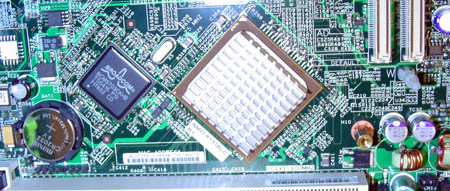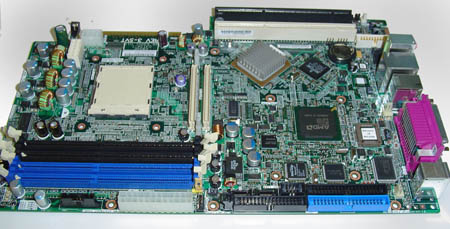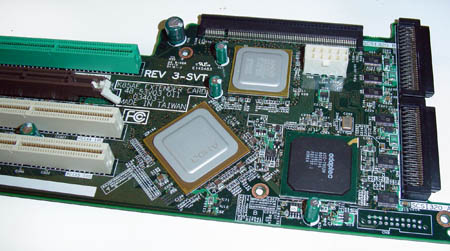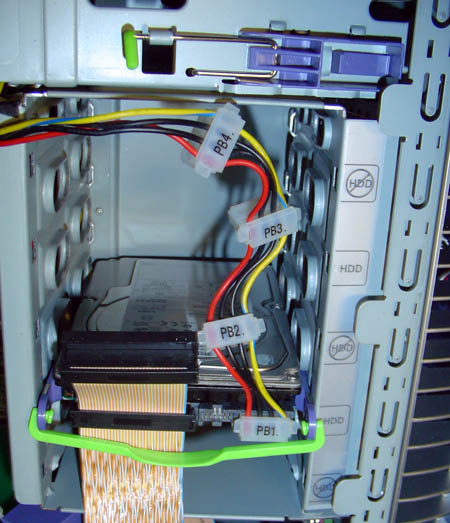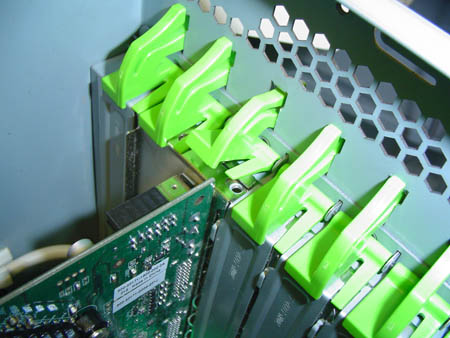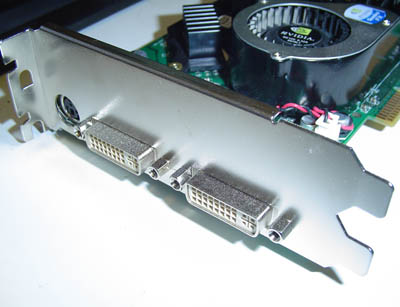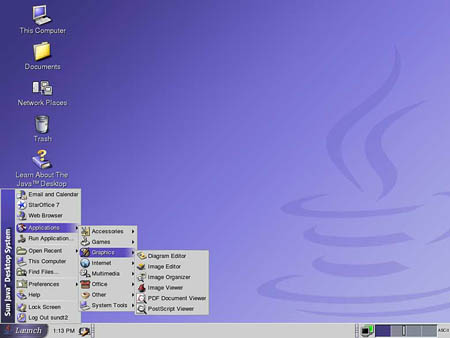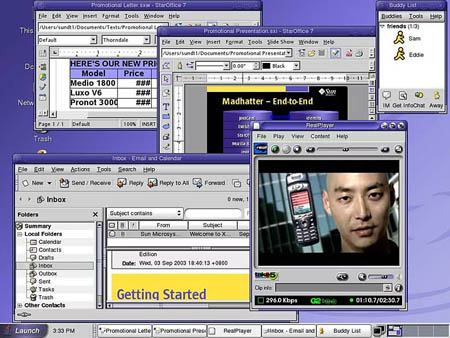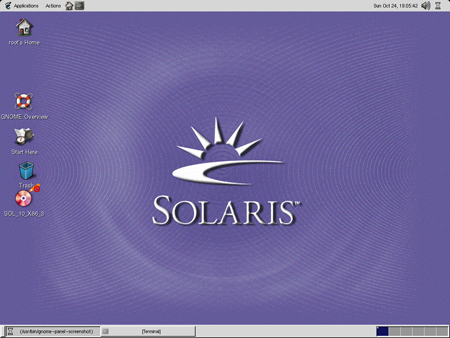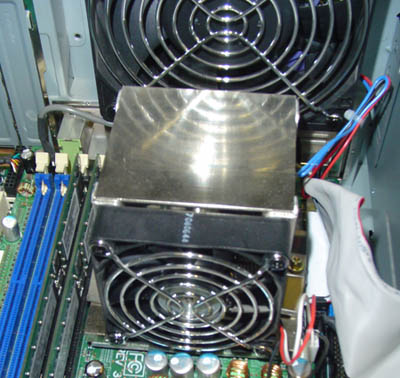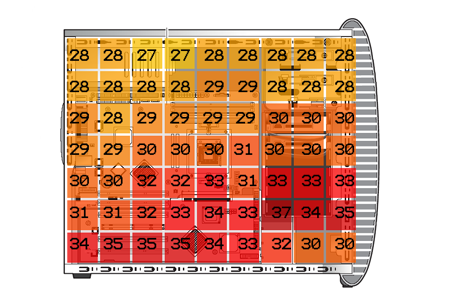
Original Link: https://www.anandtech.com/show/1523
Sun's W2100z Dual Opteron Workstation
by Kristopher Kubicki on October 27, 2004 12:05 AM EST- Posted in
- Systems
Introduction
When Sun made their first announcement that they were going to embrace AMD's x86_64 push for practical desktop 64-bit computing, we were excited. Then we started hearing details about Solaris 10, Looking Glass, Sun Java Desktop System and countless other new technologies to catapult Sun back into the workstation market, even if they weren't going to use those incredible SPARC processors exclusively anymore. When Sun approached us for an opportunity to check out their newest dual Opteron 250 based performance workstation, we had to oblige!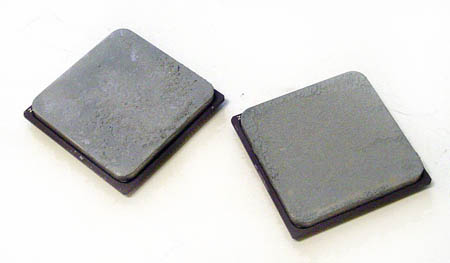
We are approaching our Sun w2100z as a system review, but in actuality, this is just as much a Linux review than anything else. We have already seen Linux performance tests of Opteron/Athlon 64 setups performing excellently in memory intensive applications, both on 32-bit and 64-bit platforms. Although most of our benchmarks are 64-bit Linux oriented today, we have a brief look at Sun's Java Desktop System 2.0 and Solaris 10 in the review, which are both 32-bit SMP kernels. We are also going to focus on some other operating systems configured for the w2100z as well as a slightly comparative analysis of a comparable system built with off-the-shelf components.
Ultimately, our goal will be to decide if Sun's w2100z is worthy of the buzz that it has created in the industry. We have structured our analysis so that anyone can easily compare the w2100z to their own test setup or even future setups that we have lined up for review. Most importantly, we will be assessing why one configuration performs better than another; benchmarks require us to read between the lines for the entire picture.
Eventually, we plan to build on this analysis of the Sun w2100z with comparisons from other Opteron workstations - this is the first in a series of Linux workstation articles.
Components
The simplest way to detail the Sun w2100z is to just open it up and look at what Sun put under the hood. Our side panel on the workstation actually provides us with detailed knowledge of how the system works. You can see the side panel reference below.The core of the Sun w2100z is its K85AE motherboard. The K85AE is wildly different from anything to which we are accustomed, even when looking at server motherboards. Sun's modular approach to component design makes it a lot easier to upgrade (providing you use Sun components) and in turn, gives Sun customers a uniform base of components to pick and choose. Our particular w2100z came with all of the options, so we can detail them here.
| Sun K85AE Specifications | |
| CPU Type | (2) AMD Socket 940* |
| Memory Banks | (4) 1GB PC-3200 ECC DDR* |
| HyperTransport Tunnel | AMD 8111 |
| AGP Tunnel | None |
| PCI Tunnel | AMD 8131 |
| SATA | Silicon Image Sil3512 |
| PCI Slots | (1) 133MHz PCI-X (1) 100MHz PCI-X |
| SATA Ports | (2) U150 |
| PATA | (2) ATA100 |
| Audio | Realtek ALC655 AC'97 |
| Network | Broadcom BCM5703 Gigabit Ethernet |
| Firewire Ports | (2) |
| USB 2.0 Ports | (2) |
You'll notice the star next to the CPU type and Memory banks. The K85AE is a single CPU motherboard with a "CPU mezzanine" - two risers (one for power, one for IO) rise up through the center of the motherboard to provide four additional DDR banks and one additional CPU slot. Sun only needs to produce a single motherboard design and significant space inside the motherboard is saved. The idea of a CPU mezzanine is not new - particularly for Sun - but seeing such technology up close is always exciting. Below, you can see the CPU mezzanine removed from the system (a high resolution reverse side image can be found here.
There isn't anything too interesting about the mezzanine itself. Sun somewhat exploits the design of Opteron by placing the memory on the mezzanine with the CPU. Remember, all Athlon 64 and Opteron processors have their own memory controllers - each processor has its own memory bank. Technically, the primary Opteron on the motherboard can utilize the memory on the mezzanine via the HTCN bridge, although there is a performance hit by doing so.
The CPU mezzanine sits directly on top of the AMD 8111 HyperTransport hub and the first AMD 8131 PCI-X tunnel. Removing the mezzanine also reveals the Broadcom gigabit Ethernet controller, BIOS and SATA controller. You can read more about the SI controller here, and more about the Broadcom controller here. Both devices have fairly strong Linux support as we will see later in our analysis. The fact that our SATA controller only supports two drives is not of huge significance, since the chassis can only hold two drives anyway. Below is an image of both controllers once the CPU mezzanine is removed. The AMD 8131 is covered by an aluminum heatsink.
The entire board layout without the extender card can be seen below (those interested in a high resolution reverse side image can get that here:
The K85AE mainboard is far from legacy free. When we first unpackaged the workstation, we were surprised to not see any PS/2 interfaces (the included keyboard and mouse are USB). Under closer inspection, we noticed that PS/2 connectors did in fact exist, but they were covered by the EMI shield from the case. The motherboard houses two serial connectors and one parallel connector as well.
Also note the 133MHz PCI-X connector (black). The majority of peripheral components on the mainboard are very basic including the Realtek AC'97 audio controller. Sun seems very shy on USB, including only five devices (two of which must be used for the keyboard and mouse unless the PS/2 ports are revealed).
Motherboard (continued)
The K85AE Extender card is the workhorse of the K85AE subsystem. The heavy disk IO, AGP and additional PCI-X interfaces all converge on the expansion card. You can see an image of the extender card below, and once again, those interested in a reverse side high resolution scan can download that here.| Sun K85AE Extender Card Specifications | |
| AGP Tunnel | AMD 8151 |
| PCI Tunnel | AMD 8131 |
| SCSI Controller | Adaptec AIC 7902W |
| PCI Slots | (3) 100MHz PCI-X |
| AGP Slots | (1) 8X AGP |
| SCSI Ports | (2) 68-pin u320 |
You will notice that the second 8131 PCI-X tunnel does not require a heatsink on the extender card. There is no CPU mezzanine covering this chip, so it probably stays cool enough on its own without additional passive cooling. We are excited to see multiple 8131 tunnels on this Sun workstation. Several four- and eight-way setups utilize multiple 8131 tunnels as well (usually one for every two processors). When we see that Sun starts to implement dual core Opterons in their workstations and servers, machines like the w2100z won't be as affected by IO bottlenecks - but we will have to wait a few months before putting that theory to test.
The Adaptec AIC 7902W is a tried and true dual channel SCSI adaptor. A dual channel adaptor may be a bit of overkill on this workstation, since we can only use two hard drives, but we are sure that there are some professional applications for such hardware out there somewhere.
Oddly, the AGP 8X slot is labeled as an AGP Pro adaptor. This is obviously not the case as can be seen in the image - we just have a plain, old AGP 8X adaptor. Looking at the traces, the expansion board and AMD 8151 AGP tunnel are both certainly capable of AGP Pro cards. Fortunately, AGP Pro compatibility is fairly insignificant as AGP Pro has fallen way to AGP 8X cards with additional power molexes on board.
Putting It All Together
The immediate difference between a whitebox configuration and the Sun w2100z is the level of design and attention to detail. Our w2100z only comes with one system fan, a 120mm exhaust. An 80mm exhaust fan provides cooling inside the power supply, and each processor also incorporates 80mm fans in their design - we will go into more detail about the heatsink fan (HSF) design in the thermal section of the analysis. There are no intake fans on the workstation. Sun relies on enormous amount of passive cooling for the workstation. For example, only two hard drives may be placed in the system and they must be placed a bay apart from each other. You can see an example of this below.You can see from the image that alternating bays are marked for cooling rather than hard drive storage. Two hard drives may seem like the bare minimum for a performance workstation, particularly if any sort of PVR work is in order, but the fact that Sun can passively cool both drives and the rest of the machine without any intake might be a design win in itself. Also notice the somewhat unique screwless plastic rails on the drive. Pulling the green handle unclips the purple rails and allows us to slide out the drive.
As long as we are on the subject of tool-less design, we were also particularly impressed with Sun's approach to the expansion bay. Below, you can see the green retention clips holding the PCI/AGP cards in place.
Removing an expansion card requires us to pinch the green clip from the outside of the case and then lift it up. For those of you who follow our case reviews closely, this is an excellent, well thought out design. Cable management was not as perfected as some other system builds that we have seen in the past, particularly along the power supply. While not overwhelming, Sun could use a slight bit of improvement in this area, particularly since they have gone through so much care to label and document each port and cable clearly on the system.
Although the tool-less design of the case is an excellent design win, the heavy weight of the system was surprising. The Sun website lists the shipping weight of the workstation at just under 60lbs! Most of this weight seems to stem from the all-steel construction of the case - the motherboard mounting plate seems almost to be reinforced with additional steel. Additional steel may have some passive cooling qualities, but we do not have the ability to test that theory. The aluminum front bezel deceives us into thinking that the workstation is much lighter than it really is, but then again, most people don't lug their high end workstations around after the initial setup all that often anyway.

Below you can see the standard IO specifications for the system. Again, keep in mind the included keyboard and mouse use up 2 of the 5 USB ports.
| Sun w2100z System Specifications | |
| 5.25" Expansion Bays | 3 |
| 3.5" Expansion Bays | 4, 2 usable |
| Rear USB Ports | 3 |
| Forward USB Ports | 2 |
| Rear Firewire Ports | 1 |
| Forward Firewire Ports | 1 |
| On-Board Parallel Port | 1 |
| On-Board Game Port | 0 |
| On-Board Serial Ports | 2 |
| Front Audio Jacks | 1 in, 1 out |
| Rear Audio Jacks | 1 in, 1 out |
| SPDIF | 1 |
| Number of Fans (including CPU/chipset) | (1) 120mm exhaust (2) 80mm CPU |
| Power Supply | 550W AcBel |
Sun included various other components for our analysis of the w2100z. The included QuadroFX 3000 (~GeForceFX 5900) is important for our OpenGL SpecViewperf benchmarks, but can be upgraded fairly easily. Our FX 3000 is a dual DVI video card, but Sun includes two DVI to D-sub 15 dongles for CRT users.
Our Sun w2100z can make use of 16GB of PC-3200 DDR by default. We are only using 4GB of buffered ECC memory as seen below. The Micron DIMMs utilize a BGA chip design.

Sun Java Desktop System 2.0, SuSE Linux
By default, our w2100z does not come with any operating system. The Sun Java Desktop System would be the logical desktop for most to run on a Sun hardware platform. JDS is not exactly an operating system, but actually an alternative X desktop/environment to KDE or Gnome. You can check out more information about JDS here.Some JDS 2.0 applications are fairly dated, but that doesn't particularly mean that JDS is any less powerful. JDS revolves around Sun's StarOffice 7 suite on top of a modified GNOME desktop. RealPlayer, VNC, GAIM, Mozilla and Evolution are also integrated into JDS as well.
The similarities between the SuSE desktop and the JDS are very prevalent. We see the same YAST software manager and YOU online update - the only difference between YOU updates from a Sun repository instead of a SuSE one.
Sun also bundled the Looking Glass Project with our JDS desktop. Although just barely useable at this point, Looking Glass aims to be one of the first "true" 3-Dimensional desktops. Looking Glass feels a lot like the MacOS X desktop, allowing us to page through applications via a graphical list of icons in the middle of the screen. Of course, being Sun, there is a heavy dependence on Java and the only real applications that give us any additional features in Looking Glass are Java based. We will look more into Looking Glass as it evolves, but in the meantime, feel free to download the demos of the desktop from Sun's project page and the Java.net development page.
JDS's competitive edge over some other distributions mostly lays in its design, Sun designed JDS as an enterprise operating system and thus, workstation stability is paramount. Falling under Sun's corporate support wing is a plus, and the pricing certainly isn't bad either. JDS's nearest competitor, Ximian XD2, offers the OpenOffice suite instead of StarOffice, but costs $100 for full support.
JDS is still in its infancy. The fact that JDS does not support 64-bit Linux operation is disappointing, but it is not its downfall. In fact, for those who want a quick, simple desktop designed around StarOffice 7 (which usually costs $80 by itself), JDS is a very neat solution. Getting Sun's tech support resources for $50/year is a great deal for many users, but it comes free with our w2100z.
Solaris 10
Getting to see Solaris 10 for the first time was something that we were excited about as well. Solaris 10 x86 runs an abstract translation layer called Project Janus. Even though Solaris already behaves very similarly to Linux, the underlying system hooks and calls differ. Janus claims about a five percent decrease in performance, but proprietary features such as the N1 Grid Containers and the ZFS Dynamic File System are supposed to offset the performance hit.Solaris 10 also boasts tons of other new features slated for final release, including a rewritten network stack and filter, cryptographic infrastructure and predictive self healing. Unfortunately, like JDS, there are no 64-bit distributions of Solaris on x86 yet. We downloaded an evaluation copy of Solaris 10 b63 to give the operating system a test drive, hopefully on our workstation benchmark.
Solaris 10 didn't get any easier to install since Solaris 9. Our first few attempts at installing the operating system failed, generally looping us in the install/configuration utilities forever. The graphical install was much friendlier on us and once we figured out the basics, Solaris 10 was up and running. Our uname reveals:
# uname - a
SunOS unknown 5.10 s10_63 i86pc i386 i86pc
Solaris 10 supports CDE and GNOME 2.0, and since we are a little more familiar with GNOME, that is what we chose. For many of our benchmarks, we are going to run Solaris binaries. However, some binaries like Maya and Shake do not have Solaris ports. Unfortunately, since Janus has not been integrated into the kernel yet, we cannot run these tests just yet.
The Test
Testing the w2100z is difficult, since there are very few dual Opteron 250 rigs on the market right now. We had the opportunity to set up a dual Opteron 250 workstation using store-bought components for our tests. This will likely change as more Tier 1 workstation companies start working closer with AMD. The majority of our tests are conducted in the same manner as our Linux CPU and GPU tests in the past. Since this is a workstation, we want to focus the majority of our benchmarks on applications that we would use in a workstation: compiling, rendering and encoding tests.We took various benchmarks that we are familiar with and ran them on various configurations of the w2001z. As we mentioned earlier, the w2100z does not come pre-installed with any operating system. As a result, we took several different operating systems (Solaris 10, JDS 2.0, RedHat 9, SuSE 9.1) with similar gcc/kernels and benchmarked our programs on them. For reference, we took our off-the-shelf Opteron 250 rig and ran the same benchmarks on it using SuSE 9.1 as well. Although we upgraded the GCC libraries and glibc for the JDS 2.0 configuration, we did not change the kernel - JDS was designed around the 32-bit SMP Linux 2.4 kernel, and upgrading/hacking it would put us well outside the scope of the analysis. As we will see in the next few pages, performance on the proven 2.4 kernel is actually surprisingly good!
Finding properly threaded applications on Linux that are capable of taking advantage of multiple CPUs is a difficult task. While lots of server applications are designed for multiple threads, as the need for multiple users exist, applications that fully utilize multiple processors in a single user environment are difficult to come by. This makes it very challenging for us to benchmark applications effectively using multiple processors. Almost all of our benchmarks only utilize a single CPU unless stated otherwise.
All of our tests take place in the 64-bit environment, with the exception of the JDS rig. Although there is nothing to prevent us from running on 32-bit operating systems, (most) of our applications are mature enough to take a performance hit in a 64-bit environment.
| Performance Workstation Configurations | ||
| Processor(s): | (2) AMD Opteron 250 (130nm, 1MB L2, Socket 94) | |
| RAM: | 4 x 1024MB Buffered ECC PC-3200 CL3 (400MHz) | |
| Motherboards: | Sun K85AE | Tyan K8W S2885ANRF |
| Hard Drives | SCSI u320 Seagate Cheetah 10,000RPM | SCSI u320 Quantum Atlas 10,000RPM |
| Memory Timings: | Default | |
| Video Card(s): | GeForce QuadroFX 3000 | |
| Operating System(s): | SuSE 9.1 Professional RedHat 9 JDS 2.0 Solaris 10 |
SuSE 9.1 Professional |
| Kernel: | Linux 2.6.8 Linux 2.4 (JDS 2.0) SunOS 5.10 s10_63 (Solaris 10) |
|
| Compiler: | linux:~ # gcc -v Reading specs from /usr/local/lib/gcc/i686-pc-linux-gnu/3.4.2/specs Configured with: ./configure Thread model: posix gcc version 3.4.2 |
|
| Drivers: | NVIDIA Linux 1.0-6111 | |
The majority of the differences between these two systems result from different motherboards and slightly different hard drives. Most of our benchmarks do not particularly stress hard drive IO, and focus more on CPU and memory IO. Generally, we average three passes of our results unless stated otherwise. Variance is noted, if above 2%.
Synthetic Benchmarks
Spec Viewperf 8.0.1 (GCC 3.4.2)
SPEC released their newest benchmarks just a couple of months ago, and we have been doing our best to validate SpecViewperf 8.01 as our main synthetic benchmark for some time. Our Viewperf was compiled via GCC 3.4.2. Much to our surprise, Viewperf 8.0.1 compiles without much tweaking. We only needed to edit the Makefile to change a few X11 lib references from lib to lib64 (we are running a 64-bit environment).You may wish to check out Anand's analysis of the FX-55 processor. Anand has a very good breakdown of each individual test, and what they mean. Do keep in mind that his analyses are done in a 32-bit, single CPU Windows environment and are very difficult to assess comparatively next to our SMP Linux tests.
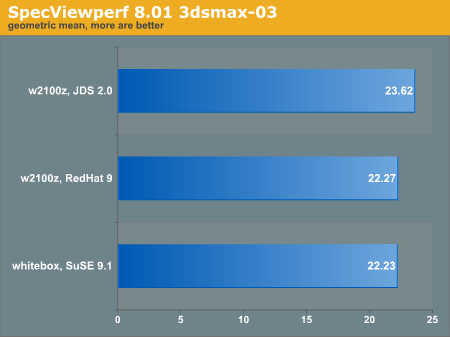
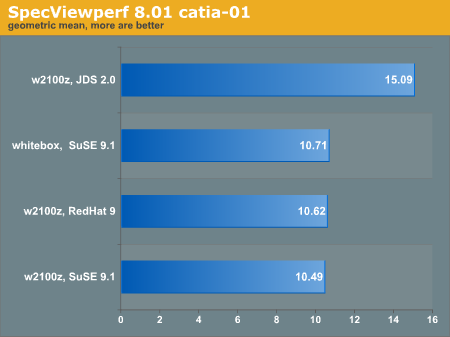
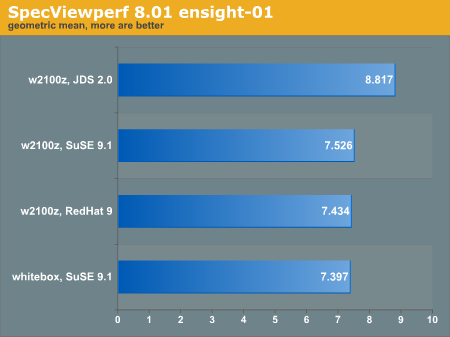
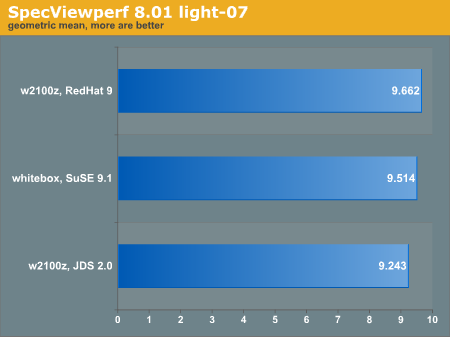
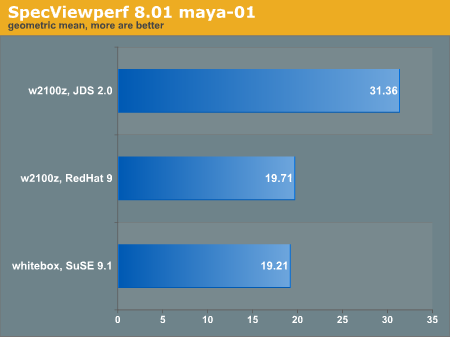

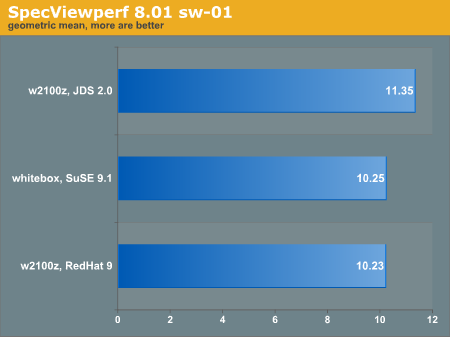
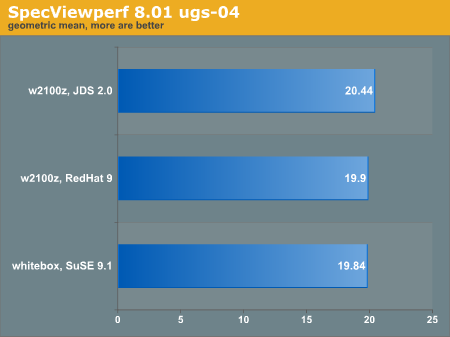
We found some very interesting results here. Almost all of our applications favored the 32-bit Linux 2.4 kernel over the 64-bit Linux 2.6 kernel! As you will see in our next few benchmarks, the 32-bit JDS platform actually performed poorer than our 64-bit platforms in almost every instance. While SPEC's benchmarks are the industry standard, we put more weight on real world rendering benchmarks, like Shake and MentalRay, which you will see on the following pages.
When compared to Anand's windows benchmarks, some applications favor our Linux setup thoroughly, although they could be benefiting from our dual processor setup. In any case, they are not particularly comparable as we are comparing "32-bit Windows" apples to "64-bit Linux" oranges. Perhaps, we will explore the differences between the performances on the two OS's again in the future. Also keep in mind that Anand uses a PCIe Radeon X800XT video card whereas we are using an AGP Quadro FX 3000. Differing video cards will change the results significantly.
We attempted to run Viewperf 7.1.1 as well, but we ran into several issues. The first time that we ran 7.1.1, the machine actually rebooted with no errors or warnings. We suspect something may have overheated, but there were no indications of that from our thermal tests that we ran after the reboot. Faulty code may also be to blame; the benchmark always crashed 2/3 of the way through on our RedHat 9 workstation.
3D Rendering Benchmarks
Mental Ray 3.3.1 (binary)
Just as Viewperf is our definitive synthetic benchmark, MentalRay has been our long time rendering standard. MentalRay was actually first developed on Sun machines during its early stages, and it's interesting to see that we have come full circle to testing MR on an x86_64 machine designed by Sun. Keep in mind, we are running the 32-bit binaries developed by Alias Wavefront. You may be interested to see how some single CPU setups perform on the same test render here. Once again, we are running the same Maya benchmark file found in our other reviews. We ran MentalRay via Maya using the command below:# maya_render_with_mr - file Benchmark_Mental.mb
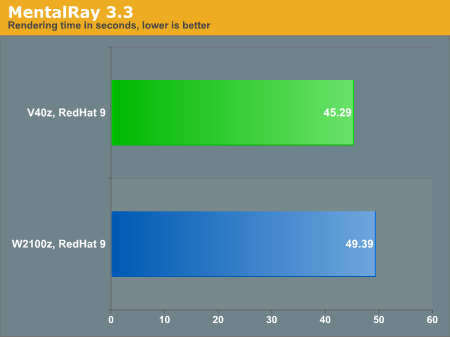
MentalRay scales very nicely on the SMP Opteron machine. You will notice a 40% increase in performance from our single CPU Athlon FX-53 in our Linux CPU Roundup, although we are running a slightly newer kernel in this analysis.
POV-Ray 3.6 (binary & GCC 3.4.2)
Below, you can see how a non-commercial single CPU renderer performs on our machine. A separate add-on for POV-Ray, such as SMPOV, is needed to enable multiprocessor support. We ran two tests of POV-Ray here, the first being the 32-bit binary package from POVRay, and the second being the compiled binary. Obviously, the compiled binary defaults to 64-bit on systems capable of such.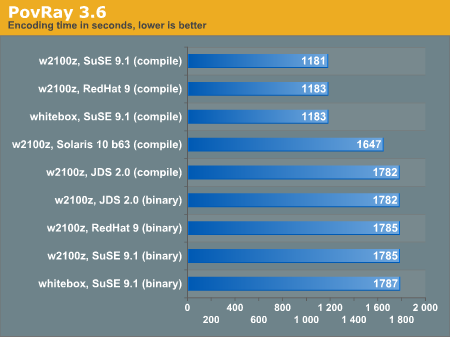
Surprisingly, POV-Ray does OK on 32-bit Solaris 10, mildly outpacing the 32-bit Linux compilation. We could be in for a real treat when Solaris shows up on the x86_64 architecture.
YafRay 0.0.7 (binary)
Blender's raytracer, YafRay, constitutes another cornerstone of Linux workstation performance. We are only running the 32-bit YafRay binaries instead of compiling from source. We rendered the blurref sample included with Blender as follows:# time yafray blurref_sample.xml
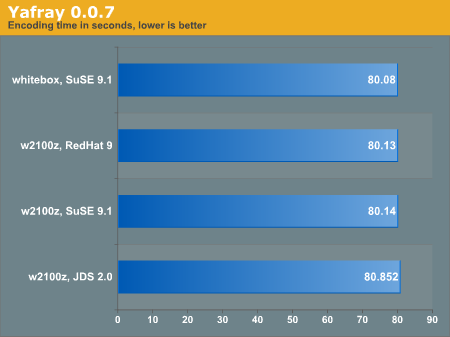
2D Rendering Benchmarks
We went out on a limb and included a very powerful, new benchmark to our rendering applications portfolio. Apple develops a great digital effects package called Shake. We took the opportunity to run a new(ish) benchmark script by Lindsay Adams, which you can download here. The benchmark script renders 10 frames under various effects using one or multiple CPUs. We sum the render times and display them below. The command run for this benchmark is:# shake - exec hardware_test_v01.shk - vv
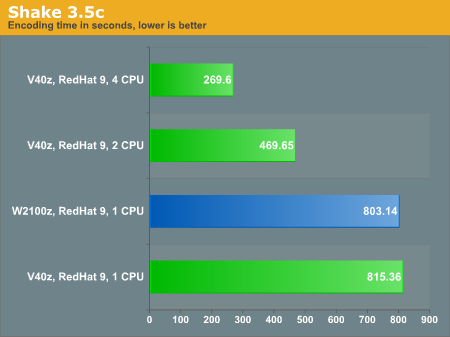
# shake - cpus 2 - exec hardware_test_v01.shk - vv
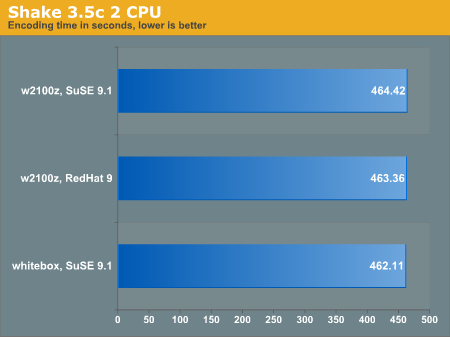
Shake utilizes multiple CPUs, a feature most of our other benchmarks lack. You can see clearly how the benchmark scales as multiple CPUs are added; over a 40% increase in performance by going to a second CPU. This is consistent with other benchmarks that we are seeing, which are capable of multiple threads.
Encoding Benchmarks
Lame 3.96.1 (GCC 3.4.2)
No workstation roundup would be complete without at least a few simple encoding tests. Below, we have some content creation programs that we would commonly use in intensive workstation applications. We start off with lame 3.96.1, the de facto Linux MP3 encoder. The command to run our benchmark with a 700MB# lame 01.wav -b 192 -m s -h - > /dev/null
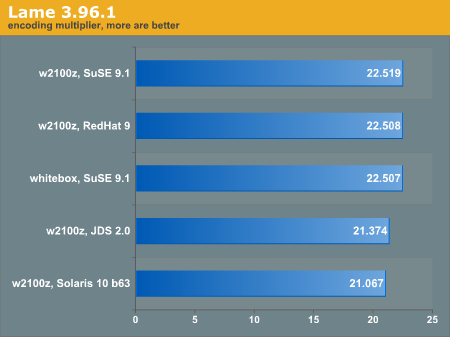
We use the same .wav sample file from our previous CPU benchmarks. It's important to note that lame is not multithreaded; it only utilizes one CPU at a time. We attempted to use BladeEnc and the MPI/LAM infrastructure to utilize both CPUs during the encoding, but we actually ended up with poorer performance going from one CPU to two.
Gzip 1.3.5 (Binary)
We took the same 700MB file from the lame encoding test and compressed it using gzip using the following command.# time gzip 01.wav -c >/dev/null
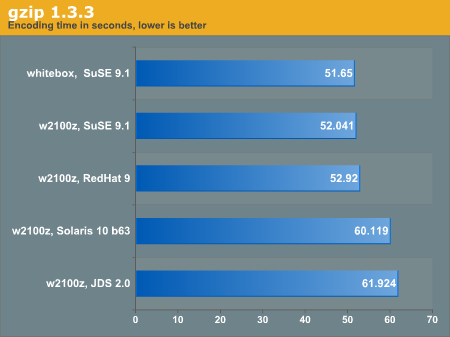
Again, you can see how gzip performed in our previous Linux CPU roundup. Even though we use the same test file, our other Athlon 64 2.4GHz components perform slightly better. There are two main reasons for this: gzip is not a multithreaded compression utility and we receive a performance hit from the SMP kernel, and unbuffered memory on the Socket 939 runs slightly faster.
mgzip 1.2b (GCC 3.4.2)
Using an SMP implementation of gzip called mgzip, we were able to achieve much faster compression times. By default, we expect mgzip to utilize both CPUs. The command used is below:# time mgzip 01.wav -c > /dev/null
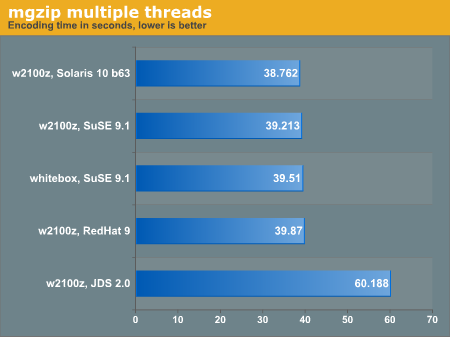
When we increased the thread count, we actually achieved even better performance (approximately 27 seconds when specifying 4 threads). By contrast, you can see that the program performs very similarly to gzip when only utilizing one thread (and thus, 1 CPU).
# time mgzip -c -t 1 01.wav >/dev/null

MEncoder 1.0pre5
Finally, we have also included a quick sample of our MPEG2 encoding benchmark. MEncoder 1.0pre5 is part of the MPlayer package and was compiled using GCC 3.4.2 using default flags.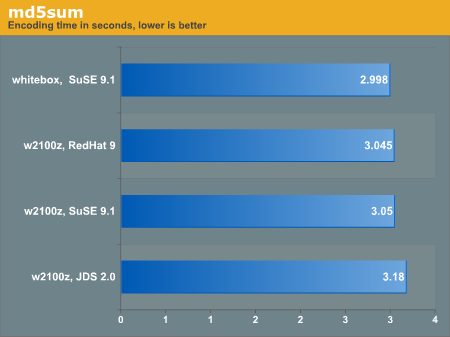
Compile Benchmarks
GNU Make 3.79.1 / GCC 3.4.2
Any programmer will always appreciate additional power during compile time. While GCC isn't multithreaded, we can run multiple jobs using the - j command in make. Below, you can see the significant improvement on performance going from 1 to 3 jobs. We did not include JDS benchmarks for this portion of the analysis, since comparing a 32-bit kernel build to a 64-bit kernel build are not comparative examples.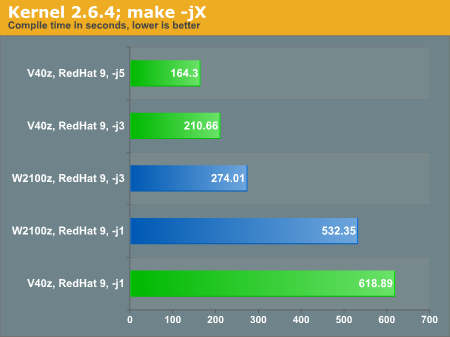

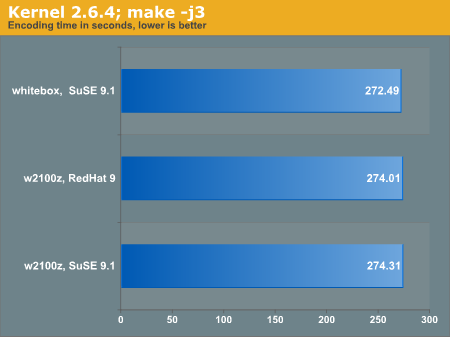
Once again, we cannot compare our old 32-bit results with our 64-bit results above. We are compiling a 64-bit kernel in a 64-bit world, whereas in our last CPU roundup, we were compiling a 32-bit kernel in a 32-bit world.
We included a few single processor compiles to demonstrate performance scales with multiple processors. For those interested, we also threw in some compile tests of entire GCC base, which take significantly longer than the Linux kernel to compile.
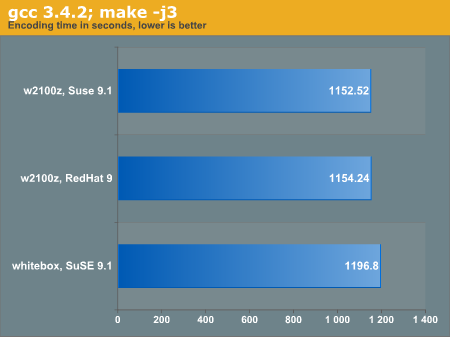
Performance differences between the three systems are very negligible, although the w2100z machine does edge out the whitebox configuration.
Encryption Benchmarks
OpenSSL
Our definitive encryption benchmark is OpenSSL's "speed" benchmark. OpenSSL calculates various times for packets to encrypt and then puts them into easy-to-read tables.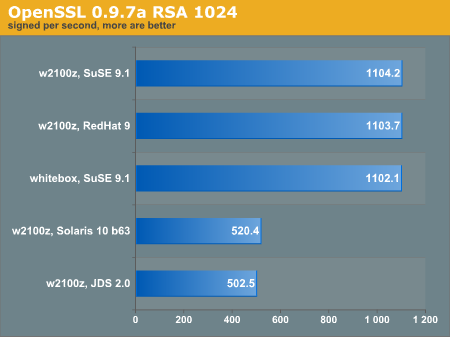
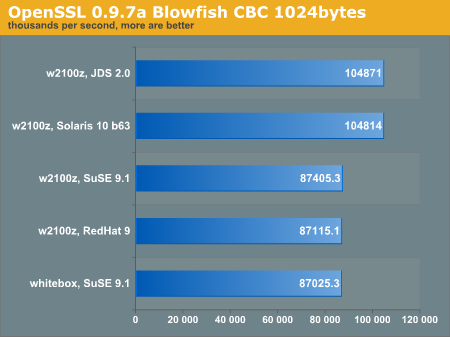
OepnSSL does not utilize both processors, and our results seem to compare directly with some of the single CPU benchmarks that we have done in the past. Surprisingly, we saw very high Blowfish throughput on the JDS system. Checking the OpenSSL tables from the benchmarks above, we notice that our JDS platform is actually slower in most instances; although, we were mildly stunned that the 2.4 kernel excelled in this one particular benchmark.
The RSA graph shows a trend to which we are also accustomed from previous CPU benchmarks. 64-bit binaries seem to double the performance of RSA signatures.
Thermals, Noise
Sonic
Having spent a considerable amount of time working on high end workstations in the past, the nagging thermal and audible "gotchas" are not issues to overlook. Many workstations perform outstanding when compared to an equivalent desktop setup, but they sound like a helicopter taking off. As we mentioned previously in the analysis, we were impressed by the simplicity and elegance of the w2100z internals. The true test of their worth seems to be when we start up the system and actually start using it. When we first set up our w2100z and the machine POST for the first time, we were greeted by the 120mm fan running at full speed, well above 50dBA! Fortunately, the initial fan speed setting seemed to only be part of the initial self-diagnostic test, and we never hear the fan peak over 30dBA for the rest of the analysis.Above, you can see the sole source of the w2100z's exhaust. If you look really closely at the EMI shield, you can see where the PS/2 ports are covered up still.
By contrast, our whitebox server setup is almost always running at or above 50dBA. The form factor is considerably different and the machine is more accustomed to sitting in a rack than on our desk. The comparison is apples to oranges, but our w2100z never makes the same amount of noise as our whitebox configuration.
Thermal
Equally important to any audible testing is a thermal analysis. We should approach any thermal testing in the same manner that one would approach any other enclosure review. In our previous enclosure analyses, we generally prefer bigger, slower moving fans over smaller, faster ones. It has been scientifically proven that when two sounds of equal dBA are compared side by side, humans tend to perceive the one with a higher pitch as "louder". Based on this premise, and the premise that larger fans move air over a larger area than smaller ones, Sun's layout for their exhaust makes a lot of sense. During our review, we did not see the fan peak over 2500 RPM, and generally, it averaged around 1100 RPM. 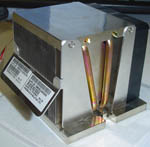 |
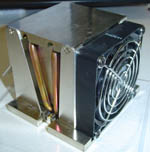 |
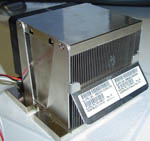 |
| Click to enlarge. | ||
Sun's heatsink/fan (HSF) combos are made almost entirely of aluminum, but unique because they employ a side fan and a system of heat pipes. Lately, every third-party manufacturer seems to have some heat pipes in their CPU coolers, so we weren't particularly surprised that they were adopted in the w2100z as well. The heatsinks play an integral role in Sun's very carefully designed thermal footprint - they are both placed in line with the 120mm exhaust and the second heatsink has fins to vortex hot air into the path of the 120mm fan. These small, professional attentions to detail compose part of our good impression confirming Sun's ability as a premiere workstation designer.
We added some other test points for this review to provide everyone with some thermal cross sections. The first graph shows the ambient air temperature taken from a sensor attached just off the inner wall of the side panel. You may download the CSV worksheet with each individual location tested here (under load). All positions on the graph below are measured using a digital thermometer with remote sensors at a constant ambient temperature of 22.3 degrees Celsius. After 30 minutes of looping SpecViewperf 8, we measured our workstation.
You can see that the warmest ambient air resides near the bottom of the case. As we expected, there are pockets of warm air grouping around the video card and hard drive where we have no active cooling moving air around. Most importantly, the AGP, PCI-X and SCSI tunnels are operating at significantly high temperatures and contributing to this warm air pocket. You can see the graph below, which denotes various surface temperatures of some of the components in the system. Hovering over the image reveals the temperatures of the CPU mezzanine as well.
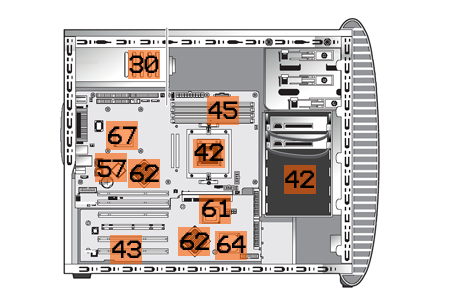
Hold your mouse over for the Overlay.
The CPUs themselves were both measured at 52 degrees Celsius under load, certainly not poor results. There is definitely a correlation between the surface temperatures of some of our components and the ambient air graph that we already saw. Temperatures on the SCSI controller and PCI tunnels are a little high and all of these components are passively cooled. Obviously, the components under the CPU mezzanine register as very warm, since they are not getting the benefits of the exhaust fan.
While testing the thermal components of the system, every time we removed the side panel, our rear exhaust fan shot up several hundred RPMs. Without the negative pressure pull across the inside of the case, the system almost immediately detects increased heat.
Conclusions
Sun is a high end name, and with a high end price, you also get high end service and documentation. Sun has an excellent forum and user community, although discussions regarding Opteron workstations are fairly limited thus far. Solaris and JDS have their own unique support systems and user communities as well.The thermal and sonic performance of the w2100z can only be described as a design win. Although Sun sacrifices our ability to incorporate multiple hard drives into the workstation by permitting only two (safely), we passively cool the entire rig well within thermal thresholds. The result is an extremely quiet workstation.
While we enjoyed out first look at the Sun w2100z, all of our testing and analyses are without a competitive solution to use for comparison. We expect this article to be the first in a set of many Linux/BSD based workstations, and we are excited about getting the Sun w2100z some competition - particularly since the next iteration of 2.6GHz Opteron processors are on the way. As you may have noticed, almost all of our benchmarks are platform independent as well; don't be surprised if an EM64T Linux, 64-bit Windows or Mac system competes head-to-head with our Sun in the future.
Although we only had a few benchmarks of Solaris 10 in this analysis, we hope to include more in the future, particularly when Janus support is fully integrated into the kernel. Thus far, we have not run enough tests on Solaris to provide conclusive results on performance.
There were no instances where the w2100z performed poorer than our whitebox configuration, including sonic and thermal testing. Let's consider how pricing modifies our final thoughts. Looking through NewEgg for each of the components used in our whitebox configuration, we made the chart below.
| Whitebox | Sun w2100z | |
| Opteron 250 | $854.00 | |
| Opteron 250 | $854.00 | |
| Tyan K8S Pro | $490.00 | |
| Kingston 1GB DDR | $314 | |
| Kingston 1GB DDR | $314 | |
| Kingston 1GB DDR | $314 | |
| Kingston 1GB DDR | $314 | |
| Quanta Altas 73GB | $250.00 | |
| GeForce Quadro FX3000 | $1,300.00 | |
| Keyboard | $20 | |
| Mouse | $20 | |
| CDR Drive | $40 | |
| Case, Power Supply | $200 | |
| Approximate Total | $5,284.00 | $8,695.00 |
Keep in mind that the Tyan K8S Pro comes with an integrated Adaptec dual channel SCSI adaptor and Broadcom gigabit Ethernet. Our whitebox configuration weighs in almost $3,000 cheaper than our Sun workstation, although this may be a bit misleading - we are not comparing apples to apples here. The whitebox Opteron system is a noisy rackmount server, and the w2100z is a high performance premium workstation. The w2100z comes with Sun backed support and software updates (not to mention free JDS), and our whitebox configuration is not even guaranteed to work under Linux.
Apple systems work well because they were designed from the beginning to work with each other. The same can be said for the Sun configuration. Heatsinks, CPU mezzanine, daughterboards are all designed and configured to work with each other, and as a result, we see higher performance, lower thermals and quiet cooling. IBM's IntelliStation A Pro 6224 (with a similar configuration) costs just $8500 with dual Opteron 248's installed; it is not available with the faster 2.4GHz Opteron 250's featured on the w2100z. HP does not offer Opteron workstations yet, although pricing out an equivalent 4U rackmount server with the same options runs in the five-digit figures. Sun does not pre-install the OS on its workstation like some of its competitors, but it is guaranteed to work with Solaris and RedHat distributions. Other solutions like Appro are priced competitively with the w2100z, but can't provide support infrastructure that we have with Sun. Ironic as it sounds, Sun is the inexpensive leader in Opteron workstation design. However, keep in mind that upgrading components for a workstation like the w2100z requires you to go through Sun (if you want to continue receiving support) - which can be costly.
There was a time when embracing Linux and x86_64 were two things that nobody expected from Sun. Memories of SGI's unwillingness to adapt to competitive (although probably not as efficient) architectures and operating systems remain fresh in everyone's minds. The lack of x86_64 Solaris and JDS thus far both indicate that Sun's interests in 64-bit SPARC are still prevalent, but small steps are better than no steps at all.
Ultimately, AMD and Sun benefit together in this new architecture endeavor. Sun and AMD research teams work closely together, and as a result, Sun can produce excellent workstations while AMD gains insight on processor and thermal design. PA-RISC, Power4 and SPARC architectures all have significant advantages over the x86 platform, with the exception of price. Seeing Sun, HP and IBM working together with AMD to advance x86 benefits us all in bringing affordable 64-bit computing to everyone.



